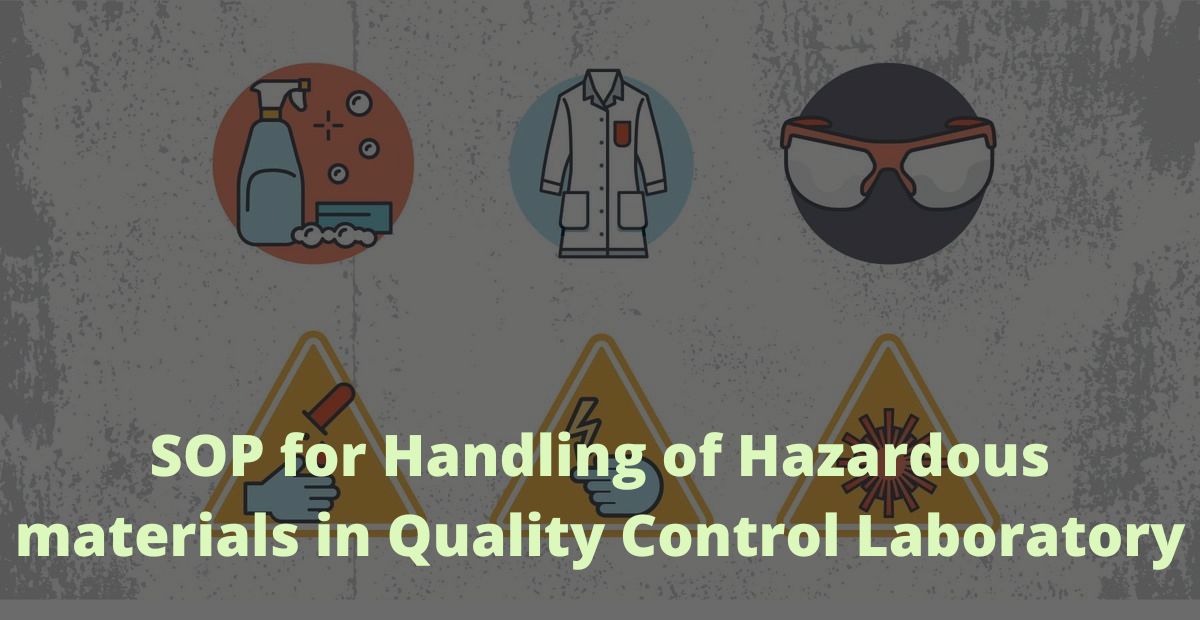
Standard Operating Procedure for Handling of Hazardous materials in Quality Control Laboratory
1.0 Purpose:
The purpose of this procedure is to describe the various steps involved in handling and
storing of hazardous materials. This procedure also describes actions to be taken in case of spillage, first aid and use of Personal Protective Equipment (PPE) etc.
2.0 Scope:
This procedure applies to various hazardous materials received, stored, tested and used in QC laboratory at [Company Name].
3.0 Responsibility:
To follow the procedure by all personnel working in QC laboratory.
4.0 Definition:
Hazardous chemicals – Hazardous chemical is any chemical that has a severe effect on health and can physically cause damage when exposed to it. This includes toxic, explosive, corrosive, ignitable, water reactive and flammable substances.
5.0 Procedure:
5.1 Precaution:
a. Safety signs/ instructions on the label of the container of material shall be read carefully.
b. While handling flammable / explosive materials appropriate fire-fighting equipment shall be kept in the vicinity.
c. Extremely toxic substances shall be handled in the presence of a co-worker.
d. List all hazardous materials used in the laboratory shall be available.
e. MSDS for all the materials shall be available.
5.2 Handling of hazardous material:
5.2.1. Personal Protective Equipment (PPE) like hand gloves, safety glasses, dust mask and respirator etc. shall be used while handling hazardous materials.
5.2.2. Handle the chemicals and solvents in such a way to avoid spillage on the working bench and the floor.
5.2.3. No chemical reagents should be pipetted out by mouth, Rubber bulb must be used for pipetting purposes.
5.2.4. Direct skin contact shall be avoided with inhalation / ingestion of hazardous material.
5.2.5. Wash hands and contacted parts of the body thoroughly with soap & water after handling such materials.
a. These materials shall be dispensed in an Open Front Containment Booth (OFCB).
b. Securely pack the material and seal it properly. As soon as the dispensing is over, wipe the outer surface of the container with a dry duster or with a duster moistened with the decontaminant.
5.3 Storage:
5.3.1. Inspect containers for packing / sealing integrity on receipt / before storage / before issue and during usage.
5.3.2. Store containers in appropriate & proper condition to avoid any damage.
5.3.3. Retain material in their original containers. Store any loose / dispensed quantity. in a secure airtight container with a proper label.
5.3.4. Store as per the storage condition mentioned on the label.
Note: Hazardous materials are generally stored in a protected area away from other materials, containers & should be prominently marked ‘Hazardous Material’.
5.4. Personal Protective Equipment: Use appropriate Personal Protective Equipment while handling hazardous materials. (Note: Single-use protective equipment should be used as far as possible.)
5.4.1. A respirator, if required, or approved dust mask should be used.
5.4.2. Rubber gloves preferably with sleeves reaching up to the elbow are used.
5.4.3. Safety glasses are used for Eye protection.
5.4.4. Protect the skin by wearing a long sleeve gown. Wear an anti-static dress, whenever required.
5.4.5. Use fully covered footwear.
5.4.6. Use safety-shoes while handling heavy load.
5.5 Spillage / Breakage: In case of spillage of hazardous material the following action should be initiated immediately.
5.5.1. Wear appropriate respirator or approved dust mask, rubber gloves, safety glasses & protective uniform, if required before handling spillages.
5.5.2. Clean solid spillage with the help of a scoop and using a vacuum cleaner.
5.5.3. If liquid spillage occurs then put absorbent material on the liquid spill and then collect with the help of scoop.
5.5.4. Place the spillage in an appropriately labeled container and store in an isolated / protected area for disposal.
5.5.5. Clean the area with dry / wet mopping and ventilate, as appropriate.
5.6. Emergency handling & First Aid:
5.6.1. In case of accidental spillage / breakage, evacuate the area, if necessary.
5.6.2. Remove the affected person from the site of exposure to a well-ventilated area.
5.6.3. Remove the contaminated clothing, if required.
5.6.4. Wash affected parts with plenty of water. Use eye-wash and body-shower.
5.6.5. Give appropriate first-aid and provide immediate medical treatment.
5.6.6. Seek medical assistance, if required.
6.0 Acceptance Criteria:
Not Applicable
7.0 Frequency:
As and when require during the quality control operations
8.0 Format for recording:
Not applicable


